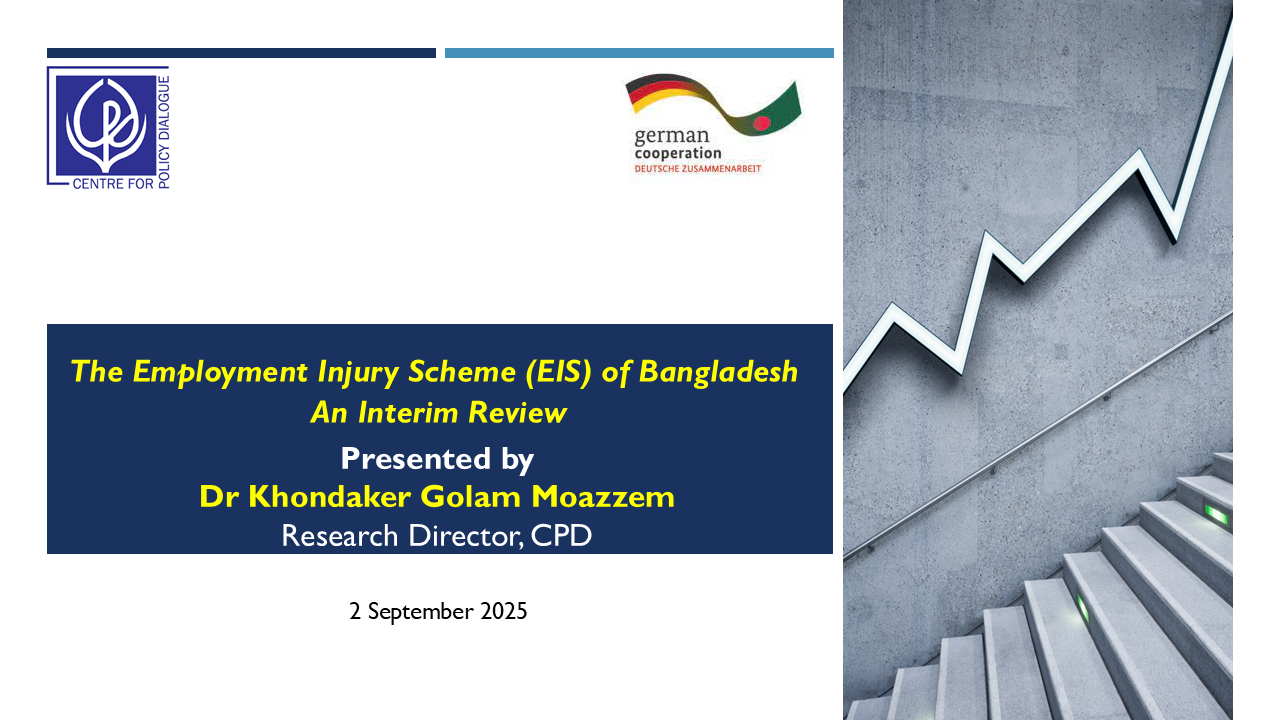Dr Khondaker Golam Moazzem, Research Director, CPD
The Employment Injury Scheme (EIS), piloted since June 2022, is a critical step towards establishing a national social insurance framework under Bangladesh’s National Social Security Strategy. This midterm review evaluates the scheme’s progress, institutional robustness, financial coverage, and operational effectiveness, alongside its gender sensitivity and expansion potential. The analysis draws on primary interviews with beneficiaries and stakeholders, complemented by secondary research and cross-country comparisons.
The EIS Pilot has evolved from initial conceptualisation in 2019 to an operational scheme covering approximately 2.8 million workers in the export-oriented ready-made garment (RMG) sector (MiB, 2024). Milestones include establishing a dedicated EIS Special Unit, integrating an MIS system, and securing voluntary brand contributions. Over 80 brands are currently involved, and significant institutional capacity has been developed through training and international cooperation. The inclusion of commuting accidents since 2024 and operationalisation in EPZs and the leather sector in 2025 reflect progressive expansion.
The governance structure adheres to tripartite principles, anchored within the Central Fund and supervised by the Ministry of Labour and Employment (MoLE). Transparent processes, internal audits, and a functional MIS system underpin accountability. Financially, the pilot operates on voluntary brand contributions; early actuarial estimates suggest a sustainable employer contribution rate of approximately USD 1 per worker annually. However, transitioning from brand-funded to employer-financed models will require phased implementation and legal enforcement.
Coverage currently extends to permanent disability and death benefits but excludes natural deaths and occupational diseases, limiting compliance with ILO Convention No. 121. The reporting and claims process, though structured, faces delays due to documentation complexity and stakeholder reluctance. Under-reporting of accidents remains a significant concern, particularly given evidence that actual cases far exceed official records. Recent integration of LIMA has improved digital reporting, but awareness and procedural transparency require further strengthening.
While the pilot incorporates gender considerations at the beneficiary level, systemic gaps persist. Female accident victims and dependants face disproportionate challenges in documentation and verification due to socio-cultural norms. Given the high female share of RMG employment and related accident exposure, mainstreaming gender-responsive measures—including simplified claims processes and targeted awareness—remains imperative.
Analysis of national accident data (2022–2025) highlights pressing vulnerabilities. Fatalities account for 76 per cent of all cases, with transport and service sectors experiencing the highest death tolls, while RMG accidents are concentrated in industrial clusters. Most accidents nationally occur in the informal sector (75.5 per cent), underscoring the need for phased EIS expansion beyond RMG. Gender-disaggregated data reveal that female victims constitute 39.9 per cent of RMG cases, reinforcing the need for gender-sensitive frameworks. Road traffic accidents dominate causal factors, affirming the relevance of commuting accident coverage.
Comparative analysis with schemes in Thailand, Cambodia, Malaysia, India, and the Philippines underscores the necessity of legal mandating, employer-financed contributions, and integrated institutional systems. These schemes provide comprehensive benefits—including medical care, rehabilitation, and occupational disease coverage—within robust enforcement and penalty frameworks, offering critical lessons for Bangladesh.
Recommendations and Way Forward
- To scale the EIS nationally by 2027, reforms are essential across three dimensions: (a) legal; (b) institutional; (c) operational.
- Legal reforms: Amend the Bangladesh Labour Act or enact a dedicated law to mandate participation, include penalties for non-compliance, and update occupational disease lists.
- Institutional reforms: Formalise MoLE as the oversight body, strengthen the EIS PSU, and establish regional offices to decentralise service delivery.
- Operational reforms: Create a pre-registration system, integrate databases under LIMS, enhance digital reporting, and extend coverage to occupational diseases and mental health.
A phased roadmap for expansion should prioritise awareness-raising, employer onboarding, and gradual sectoral inclusion, beginning with high-risk industries. Government proactiveness and resource mobilisation are critical to ensure sustainability and credibility in meeting global labour standards.




